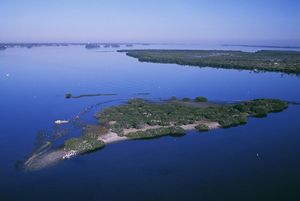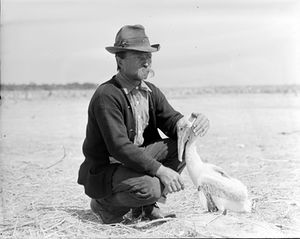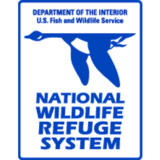National Wildlife Refuge System
The first national wildlife refuge, Pelican Island National Wildlife Refuge, was established in Florida in 1903 by President Theodore Roosevelt for the protection of colonial nesting birds from plume hunters and egg poachers. Following suit for much needed wildlife protection, western refuges were established for American bison (1906), elk (1912), prong-horned antelope (1931), and desert bighorn sheep (1936) after over-hunting, competition with cattle, and natural disasters decimated once abundant herds.
National wildlife refuges in the first decades of the 20th century were true sanctuaries. Many were guarded by citizen wardens, such as Paul Kroegel, who protected them from poachers and plume hunters, while visitors were rare: an occasional scientist, photographer, or bird watcher.
Since the first wildlife refuge was created in 1903, the National Wildlife Refuge System (NWRS), has grown to include over 568 refuges. Managed by the U.S. Fish and Wildlife Service (FWS), aka the "Service", the refuge system encompasses the only federal lands managed primarily for the preservation and enhancement of wildlife resources.
Human Impact
During the drought conditions of the 1930’s “Dust Bowl”, breeding populations of ducks and geese plummeted and a waterfowl crisis ensued. The Duck Stamp Act of 1934 provided a much needed stimulus to the National Wildlife Refuge System by using hunting license proceeds to establish “Waterfowl Production Areas” to recover breeding populations of waterfowl. As the System grew under the Duck Stamp Act, some refuges were opened to hunting and fishing.
Interest in using refuges for other recreation gained popularity with the post-WW II generation of the 1950s. Americans loved to travel the nation’s back roads, and there, amidst the hot prairies and plains and the salt marshes of the south, they discovered their National Wildlife Refuge System.
In 1951, the first year visitor use records were totaled, refuges hosted 3.4 million people. By the end of that decade, 10 million people visited refuges. Some came to fish and hunt, but most came to share with family and friends the sights and sounds of wildlife and the wonders of the living world. Many came to recreate in other ways: sail, swim, camp, water ski, bicycle, ride horses, sun bathe, and rock climb.
Although these lands were dedicated to wildlife conservation, incomplete policies and an uncertain mission resulted in uses that were not always in harmony with a refuge’s wildlife conservation purpose. Refuge staff, so well-trained and equipped to manage habitat and wildlife, faced new challenges with the task of managing an eager and active public.
The Refuge Recreation Act of 1962 (16USC460k)[1] and the Refuge Administration Act of 1966 (16USC668dd)[2] helped bring refuges together, but both laws were more concerned with how refuges would be used rather than how they should function as a system. This all changed, in 1997, with President Clinton’s signing of the National Wildlife Refuge System Improvement Act (HR1420, Public Law 105-57)[3]. The Act established, for the first time, a clear legislative mission of wildlife conservation for the National Wildlife Refuge System.
The mission of the National Wildlife Refuge System (Refuge System), as defined by the National Wildlife Refuge System Improvement Act of 1997 is:
“...to administer a national network of lands and waters for the conservation, management, and where appropriate, restoration of the fish, wildlife and plant resources and their habitats within the United States for the benefit of present and future generations of Americans.”
The wildlife and habitat vision for national wildlife refuges stresses that wildlife comes first; that ecosystems, biodiversity, and wilderness are vital concepts in refuge management; that refuges must be healthy and growth must be strategic; and that the refuge system serves as a model for habitat management with broad participation from others.
Actions were initiated in 1997 to comply with the direction of this new legislation, including an effort to complete comprehensive conservation plans for all refuges. These plans, which are completed with full public involvement, help guide the future management of refuges by establishing natural resources and recreation/education programs. Consistent with this Act, approved plans will serve as the guidelines for refuge management for the next 15 years. The Act states that each refuge shall be managed to:
- Fulfill the mission of the National Wildlife Refuge System;
- Fulfill the individual purposes of each refuge;
- Consider the needs of wildlife first;
- Fulfill requirements of comprehensive conservation plans that are prepared for each unit of the refuge system;
- Maintain the biological integrity, diversity, and environmental health of the refuge system;
- Recognize that wildlife-dependent recreation activities including hunting, fishing, wildlife observation, wildlife photography, and environmental education and interpretation are legitimate and priority public uses; and
- Allow refuge managers authority to determine compatible public uses.
Economic Benefit
National wildlife refuges connect visitors to their natural resource heritage and provide them with an understanding and appreciation of fish and wildlife ecology to help them understand their role in the environment. Wildlife-dependent recreation on refuges also generates economic benefits to local communities.
According to the report, Banking on Nature 2004: The Economic Benefits to Local Communities of National Wildlife Refuge Visitation, approximately 37 million people visited national wildlife refuges in 2004, generating almost $1.4 billion in total economic activity and creating almost 24,000 private sector jobs producing about $454 million in employment income. Additionally, recreational spending on refuges generated nearly $151 million in tax revenue at the local, county, state, and federal level.
As the number of visitors grows, significant economic benefits are realized by local communities. In 2001, 82 million people, 16 years and older, fished, hunted, or observed wildlife, generating $108 billion. In a study completed in 2002 on 15 refuges, visitation had grown 36 percent in seven years. At the same time, the number of jobs generated in surrounding communities grew to 120 per refuge, up from 87 jobs in 1995, pouring more than $2.2 million into local economies.
Other findings also validate the belief that communities near refuges benefit economically. Expenditures on food, lodging, and transportation grew to $6.8 million per refuge, up 31 percent from $5.2 million in 1995. For each federal dollar spent on the Refuge System, surrounding communities benefited with $4.43 in recreation expenditures and $1.42 in job-related income (Caudill and Laughland, unpublished data).
Volunteers continue to be a major contributor to the success of the Refuge System. In 2005, approximately 38,000 refuge volunteers donated more than 1.4 million hours. The value of their service was more than $25 million.
Legal and Policy Context
The National Wildlife Refuge System Improvement Act of 1997[3] stipulates that comprehensive conservation plans (CCP) be prepared in consultation with adjoining federal, state, and private landowners and that the Fish and Wildlife Service develop and implement a process to ensure an opportunity for active public involvement in the preparation and revision (every 15 years) of the CCPs.
All lands of the Refuge System will be managed in accordance with an approved comprehensive conservation plan that will guide management decisions and set forth strategies for achieving refuge unit purposes. Each CCP will be consistent with sound resource management principles, practices, and legal mandates including Service compatibility standards and other Service policies, guidelines, and planning documents (602 FW 1.1).
Administration of national wildlife refuges is guided by the mission and goals of the National Wildlife Refuge System, congressional legislation, presidential executive orders, and international treaties. Policies for management options of refuges are further refined by administrative guidelines established by the Secretary of the Interior and by policy guidelines established by the Director of the Fish and Wildlife Service.
Treaties, laws, administrative guidelines, and policy guidelines assist the refuge manager in making decisions pertaining to soil, water, air, flora, fauna, and other natural resources; historical and cultural resources; research; and recreation on refuge lands, providing a framework for cooperation between the refuge and other partners.
Lands within the National Wildlife Refuge System are closed to public use unless specifically and legally opened. No refuge use may be allowed unless it is determined to be compatible. A compatible use is a use that, in the sound professional judgment of the refuge manager, will not materially interfere with or detract from the fulfillment of the mission of the refuge system or the purposes of the refuge. All programs and uses must be evaluated based on mandates set forth in the National Wildlife Refuge System Improvement Act. Those mandates are to:
- Contribute to ecosystem goals, as well as refuge purposes and goals;
- Conserve, manage, and restore fish, wildlife, and plant resources and their habitats;
- Monitor the trends of fish, wildlife, and plants;
- Manage and ensure appropriate visitor uses as those uses benefit the conservation of fish and wildlife resources and contribute to the enjoyment of the public; and
- Ensure that visitor activities are compatible with refuge purposes.
The National Wildlife Refuge System Improvement Act further identifies six priority wildlife-dependent recreational uses: hunting, fishing, wildlife observation, wildlife photography, environmental education, and interpretation. As priority public uses of the refuge system they receive priority consideration over other public uses in planning and management.
Questions and Answers
Source: NWR FAQ
Why are national wildlife refuges important?
Beyond their primary mission of conserving and enhancing land and water for fish, wildlife and plants, national wildlife refuges are important in other ways. They offer healthy, world-class outdoor recreation. They improve air and water quality across the nation. They help lessen the impact of natural disasters on local communities. They reduce the risk of wildfire. They help preserve the nation’s cultural heritage. They add to the nation’s economic well-being.
Are cultural and historic resources conserved on national wildlife refuges?
Yes. These resources are managed under the National Historic Preservation Act. There are 10 National Historic Landmarks, 114 National Register-listed properties, 384 paleontological sites, 1,815 historic structures and 15,798 archaeological sites within national wildlife refuges. The Refuge System also manages about 4.5 million museum artifacts.
How many national wildlife refuges are there?
The National Wildlife Refuge System includes 568 national wildlife refuges from Alaska to the Caribbean and Maine to the south Pacific. There is at least one national wildlife refuge in each state. The Refuge System also includes five marine national monuments and 38 wetland management districts.
How many national wildlife refuges are in the Indian River Lagoon watershed?
There are three National Wildlife Refuges in the Indian River Lagoon estuary; two are in Brevard County, Merritt Island NWR in Titusville and Archie Carr NWR in Melbourne Beach; and Indian River County's Pelican Island NWR is in the City of Sebastian.
Why is hunting allowed?
The National Wildlife Refuge Improvement Act of 1997 (pdf) institutionalized hunting as a priority public use on refuges. This means it is a primary focus in planning and management efforts. Hunting on refuges, carefully regulated, also is used to manage for healthy wildlife populations and habitats.
See Also
Web Links
- National Wildlife Refuge System
- Digest of Federal Resource Laws of Interest to the U.S. Fish and Wildlife Service
Documents
References
This article is an excerpt from Archie Carr NWR Comprehensive Conservation Plan 2008 (PDF 266pp 20.3MB).
- ↑ National Wildlife Refuge Recreation Act 1962 (16USC460k), retrieved 11-08-2020
- ↑ National Wildlife Refuge Administration Act 1966 (16USC668dd), retrieved 11-08-2020
- ↑ 3.0 3.1 National Wildlife Refuge System Improvement Act of 1997 (HR1420, Public Law 105-57) (PDF 10pp), retrieved 11-08-2020




